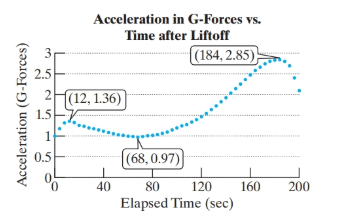
Concept explainers
A rocket will carry a communications satellite into low Earth orbit. Suppose that the thrust during the first 200 sec of flight is provided by solid rocket boosters at different points during liftoff.
The graph shows the acceleration in G-forces (that is, acceleration in 9.8-m/sec2 increments) versus time after launch.
a. Approximate the interval(s) over which the acceleration is increasing.
b. Approximate the interval(s) over which the acceleration is decreasing.
c. How many turning points does the graph show?
d. Based on the number of turning points, what is the minimum degree of a 1 polynomial function that could be used to model acceleration versus time?
Would the leading coefficient be positive or negative?
e. Approximate the time when the acceleration was the greatest.
f. Approximate the value of the maximum acceleration.

Want to see the full answer?
Check out a sample textbook solution
Chapter 3 Solutions
College Algebra with Corequisite Support
- Table 6 shows the population, in thousands, of harbor seals in the Wadden Sea over the years 1997 to 2012. a. Let x represent time in years starting with x=0 for the year 1997. Let y represent the number of seals in thousands. Use logistic regression to fit a model to these data. b. Use the model to predict the seal population for the year 2020. c. To the nearest whole number, what is the limiting value of this model?arrow_forwardWhat is the y -intercept on the graph of the logistic model given in the previous exercise?arrow_forwardCan the average rate of change of a function be constant?arrow_forward
- Use the table of values you made in part 4 of the example to find the limiting value of the average rate of change in velocity.arrow_forwardA driver of a car stopped at a gas station to fill up his gas tank. He looked at his watch, and the time read exactly 3:40 p.m. At this time, he started pumping gas into the tank. At exactly 3:44, the tank was full and he noticed that he had pumped 10.7 gallons. What is the average rate of flow of the gasoline into the gas tank?arrow_forwardThe kinetic energy E of an object varies jointly with the object’s mass m and the square of the object’s velocity v . An object with a mass of 50 kilograms traveling at 16 meters per second has a kinetic energy of 6400 joules. What is the kinetic energy of an object with a mass of 70 kilograms traveling at 20 meters per second?arrow_forward
- bThe average rate of change of the linear function f(x)=3x+5 between any two points is ________.arrow_forwardThe formula for the amount A in an investmentaccount with a nominal interest rate r at any timet is given by A(t)=a(e)rt, where a is the amount ofprincipal initially deposited into an account thatcompounds continuously. Prove that the percentageof interest earned to principal at any time t can becalculated with the formula I(t)=ert1.arrow_forward
- Algebra & Trigonometry with Analytic GeometryAlgebraISBN:9781133382119Author:SwokowskiPublisher:Cengage


 Functions and Change: A Modeling Approach to Coll...AlgebraISBN:9781337111348Author:Bruce Crauder, Benny Evans, Alan NoellPublisher:Cengage Learning
Functions and Change: A Modeling Approach to Coll...AlgebraISBN:9781337111348Author:Bruce Crauder, Benny Evans, Alan NoellPublisher:Cengage Learning Trigonometry (MindTap Course List)TrigonometryISBN:9781337278461Author:Ron LarsonPublisher:Cengage Learning
Trigonometry (MindTap Course List)TrigonometryISBN:9781337278461Author:Ron LarsonPublisher:Cengage Learning Linear Algebra: A Modern IntroductionAlgebraISBN:9781285463247Author:David PoolePublisher:Cengage Learning
Linear Algebra: A Modern IntroductionAlgebraISBN:9781285463247Author:David PoolePublisher:Cengage Learning





